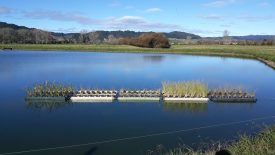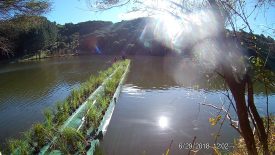By Kelly Hughes, ATS Environmental
New Zealand company ATS Environmental is working with three local New Zealand agencies to further develop a concept bringing together water treatment and the propagation of wetland plants. The intent is to improve on some of the well-understood positive attributes of “floating islands” that use plants and microbes to treat pathogens, heavy metals and nutrients in lakes and other water bodies while growing healthy wetland plants.
Part of the impetus for the project came from the observation that, while traditional floating islands have positive features, over time they can become a bit of a liability. Their maintenance and disposal are problematic, as the roots of the plants grow into the shredded plastic matrix that makes up the body of the raft. Weeds tend to get a foothold and plants typically become less effective at reducing nutrients when fully mature.
Another factor driving development of the new concept is New Zealand’s national commitment to riparian planting and wetland restoration; this technology can produce suitable plants for restoration work. As well, operational expenses should be less than those for floating islands because access is easier and the sale of harvested plants can offset costs.
There can also be opportunities for community involvement in harvesting the plants and restocking the pontoons, along with planting out the mature plants.
A rotation mold for the new technology has been commissioned with an initial run of forty modules. The polymer used is high grade UV-stable polyethylene similar to water tanks, which does not granulate over time and can be fully recycled.
Modules can be deployed individually or in a “daisy-chain” bolted together with conveyor-belt rubber; each unit can take the weight of two people and the plants. Plants remain in individual pots and are easily harvested by walking down the central walkway. The entire string can also be hauled out onto the bank by hand or with a utility vehicle.
The project is now in its second phase with two pilot projects being monitored for plant performance, structural integrity and operational issues.
The first of these uses five modules, each with different plant species, in a sewage treatment pond. (see 5 module video here )
The second pilot project uses ten modules in a eutrophic lake. Here the array will also allow field technicians to take water samples from far out into the lake without needing a boat. (see 10 module video here )
Engineers, ecologists and experts from other fields note that the technology may have additional benefits and other potential uses. For example, in addition to their primary function, the structures could provide wave attenuation or protected areas for swimming and kayaking. The modules could also be used to raise food crops like watercress.
For more information, please contact either Kelly Hughes of ATS Environmental (NZ) at kellyh@ats-environmental.com or +64 7 3124647 or Chad Dornsife of EKO RX (USA) at (775) 721-2423 or chad@ekogroupna.com











